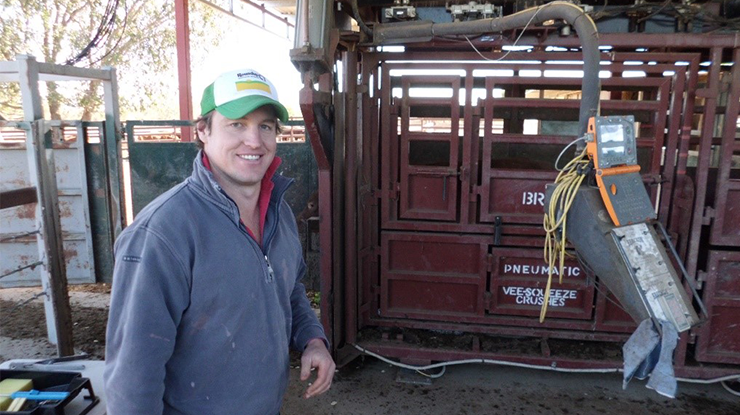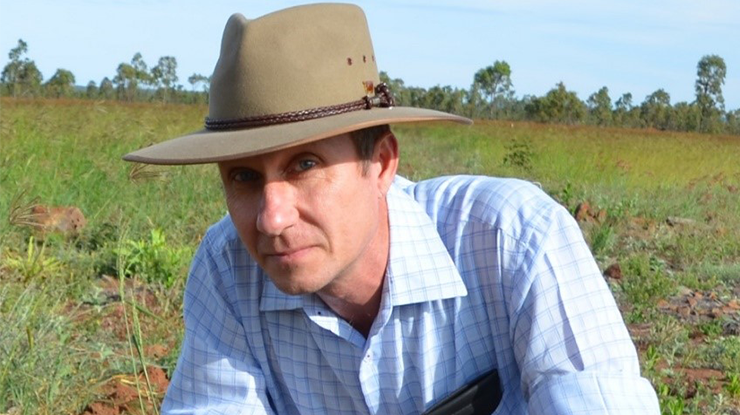Shining a spotlight on ag science
20 August 2021
To celebrate National Science Week, we’re shining a light on the way MLA scientists contribute to the world of knowledge. We’ve profiled two staff members to see how their scientific pursuits transform into on-farm practices.
Dave Packer

What is your role at MLA (what roles have you held at MLA)?
I’m the Program Manager of Meat Standards Australia (MSA). Before that, I was the Program Manager for Producer Adoption, though joined MLA as the National Adoption Manager for Genetics.
Prior to joining MLA, I worked for animal health companies in research and commercial roles and had hands-on experience across the livestock and cropping sector.
What is your scientific background? What did you study/research?
I have an undergrad in Rural Science from the University of New England. I’ve since completed a PhD in meat science, which directly related to my MSA role. My thesis reported on the impact of hormonal growth promotants (HGP) on eating quality.
What is some of the scientific research you’ve been doing in your current role?
There’s a lot going on in the MSA R&D space. Generally, we are focused on two areas. The first is making sure all sheep and cattle pathways (e.g. cattle type, production system, location) are eligible for MSA grading. This research has underpinned the MSA model and program and there’s still plenty happening within this space.
For example, a current project aims to understand the effects of consignment by train transport on eating quality. Previous MSA research had established the impact of long-distance truck transport, but to ensure options and further pathways for northern beef businesses, it is important to account for this method. The outcomes will be commercialised through the MSA program.
The other area of research we’re looking into is how to measure eating quality on a live animal or new traits to predict eating quality (both on live animal and carcase).
We’ve got a number of projects going on concerning this. For instance, we’re looking at biomarkers within saliva, in an aim of understanding if an animal may be dark cutting or not. We’re also looking at skin and hair samples from live animals and what these can tell us about eating quality.
What’s been your most important discovery / what are you most proud of?
From a science point of view, it would have to be my thesis. This was an industry question that had not been answered. The outcome was that different HGPs have different effects on eating quality. Importantly, the MSA model accounted for these differences, delivering confidence that the model provides prediction of beef from many different pathways and production systems.
What are your current goals relating to your work?
For me, it’s all about the adoption and commercialisation of the research that the broader MLA group is doing. This ensures we are realising an outcome from the investment and progressing the industry forward.
In the MSA space, this means producers will be able to make on-farm improvements and be rewarded for these. For processors and brand owners, they will be able to extract the full value of the carcases they are harvesting through optimising how they use MSA and differentiating Australian product based on eating quality and other important traits.
How will the research benefit the red meat industry?
If more animals are MSA graded, it means more value can be extracted from more carcases, including older livestock, and shared across the supply chain.
Feedback, tools and adoption programs will also improve on-farm performance, including eating quality, resulting in improved productivity and profitability.
How is this science being applied/used?
MSA is a great example of science being commercialised to realise a return on investment for the red meat industry. In just the last decade alone, the MSA program has returned almost $1.5 billion in additional farm gate returns to producers alone.
The program adds value right across the supply chain and underpins over 205 brands. It means processors and brandowners can segregate product on eating quality to extract further value and be confident that the product is consistent.
Why does the work you do matter?
I get a lot of satisfaction out of helping producers, supply chain stakeholders and the broader industry improve their production, profitability and sustainability, both business and environmental.
We’re involved in a critical industry, and red meat demand (and agriculture in general) is only going to grow in importance going forward as the need for food increases, which reassures me that my work is also really important.
Nigel Tomkins

What is your role at MLA (what roles have you held at MLA)?
I’m currently the Program Manager for Grassfed Beef, which is one of MLA’s research, development and adoption (RDA) programs.
We integrate this program very closely with MLA’s feedbase and animal wellbeing programs. Our portfolio is broad in that it involves not only grazing management but also different ways of managing those animals across some of extensive pastoral zones of northern Australia and some of the intensive pastoral zones of southern Australia.
What is your scientific background? What did you study/research?
Previous to this, I was MLA’s Project Manager for Grassfed Beef. Before that, I spent 15 years with CSIRO, based out of their labs in Rockhampton and then Townsville. With CSIRO being a national organisation, the work I was doing was not just limited to Queensland but also WA, the Northern Territory and a lot of work in New South Wales.
It was 15 very fruitful years, starting off with some feedlot work but then getting more and more involved in work to reducing methane emissions from livestock, which became part of the National Livestock Methane program. This program was managed by MLA and set the scene for our current carbon neutral by 2030 (CN30) initiative.
What’s been your most important discovery / what are you most proud of?
The most important science-based initiative for me at the moment is the Northern Breeding Business (NB2) program, which brings many research and adoption elements together with a focus around reducing calf mortality and improving breeder herd efficiency.
NB2 brings all our learnings and programs together for northern producers around better pasture management, better animal management, targeting environmental issues, improved pastures, and simple management practices to put in place on-farm to improve overall reproductive performance. If NB2 creates even a small change, even a fraction of a percentage reduction in calf mortality – if you scale it up across the industry, it will make a significant difference.
What are some other initiatives you’re working as part of your role at MLA?
We’ve done some work with Hitachi over the last couple of years and that was all about pulling data together off-farm - from weather stations, cameras and soil moisture probes – to create dashboards for producers so they had a far better understanding of their production system.
These dashboards provided an element of objective measurement property-wide, employing machine learning to make recommendations as to what a producer’s options may be for that paddock, that mob of animals, what the market’s doing right now. So that’s been very exciting.
The other neat piece of work is around the CattleAssess3D (BeefSpecs) system, which provides a live animal assessment using cameras to determine the potential carcase characteristics of that animal. That’s a very smart piece of technology that uses cameras to simulate a 3D version of that animal and determine its potential at slaughter or important carcase characteristics.
That’s the range of the sort of work under our program – it goes from individual animal management right through to the use of support technology like drones and 3D cameras.
What do you hope to achieve through the R&D you do with MLA?
One of the big targets in our work is developing methodologies for grassfed beef enterprises so they can reduce their carbon footprint.
There’s a lot you can do in intensive systems, particularly feedlots, to manage methane emissions but once those animals are out of those systems it gets really challenging to manage them. If we can demonstrate consistent mitigation for enteric methane across the northern herd, I think we’ve really got something to be proud of.
How is this science you’re involved with being applied or used?
As part of the NB2 program, we have facilitated the formation of producer groups – self-determining peer to peer learning groups where we actually expose them to the research and development (R&D) and let them assess what is the best option for their business.
With guidance through producer facilitators and coordinators, we then work with that producer group to help actually put those practice changes on-farm. We work to deliver relevant R&D so producers can start seeing where it could apply to their operation.
It’s not about handing out recipes as much as giving producers a toolbox and letting them decide what’s the best approach for their business that delivers sustainable, profitable and productive practice change.
What excites you about your work?
The best part of the role is that you get to see all these projects going on, so you can start drawing some links and getting good projects to work on together for the same outcome. You’re interacting with a range of such talented scientists and service providers, so you can really start seeing what’s going on in the bigger picture and actually identify the opportunities and partnerships that could result in more impact for individual producers and industry as a whole.


